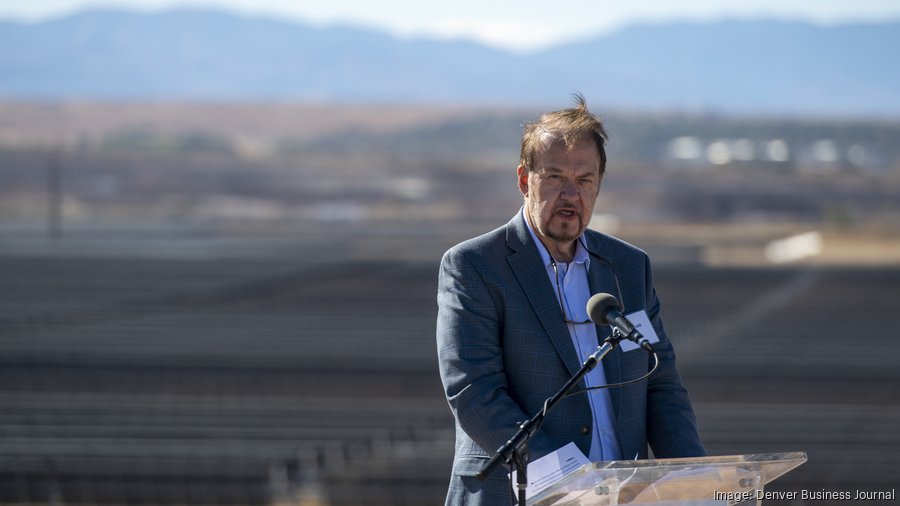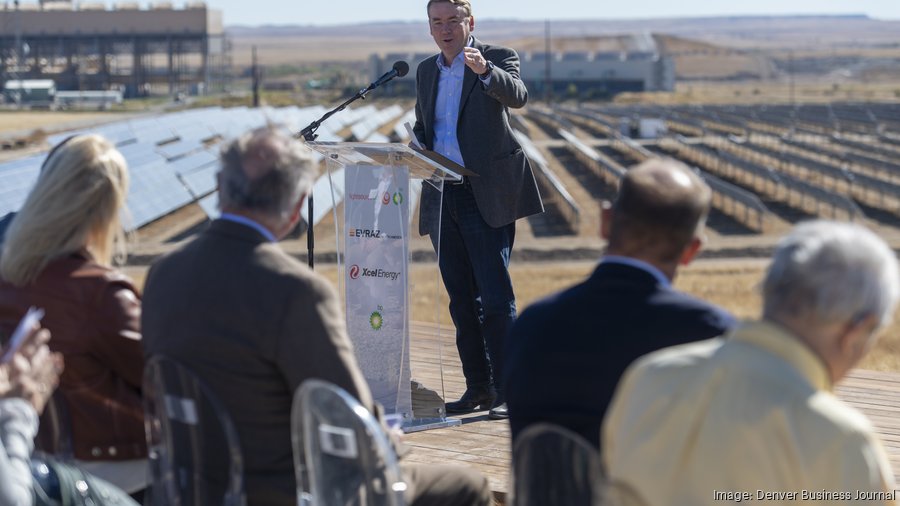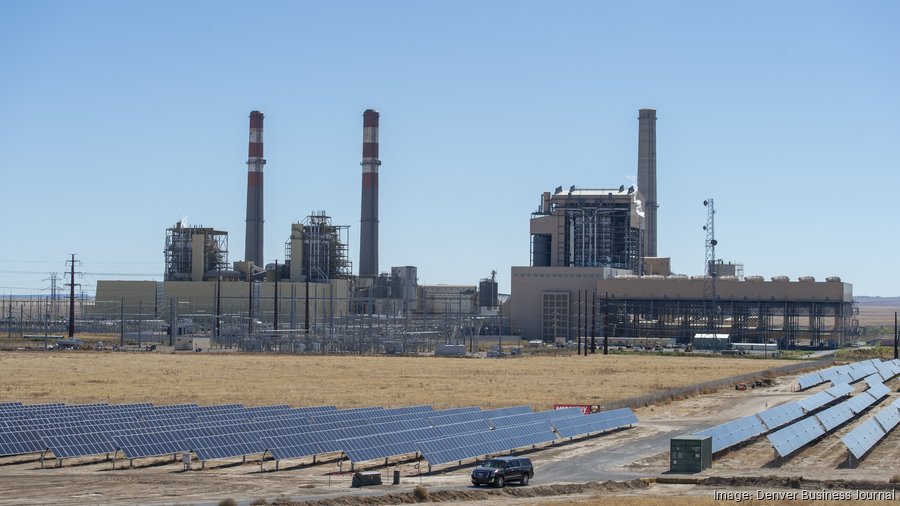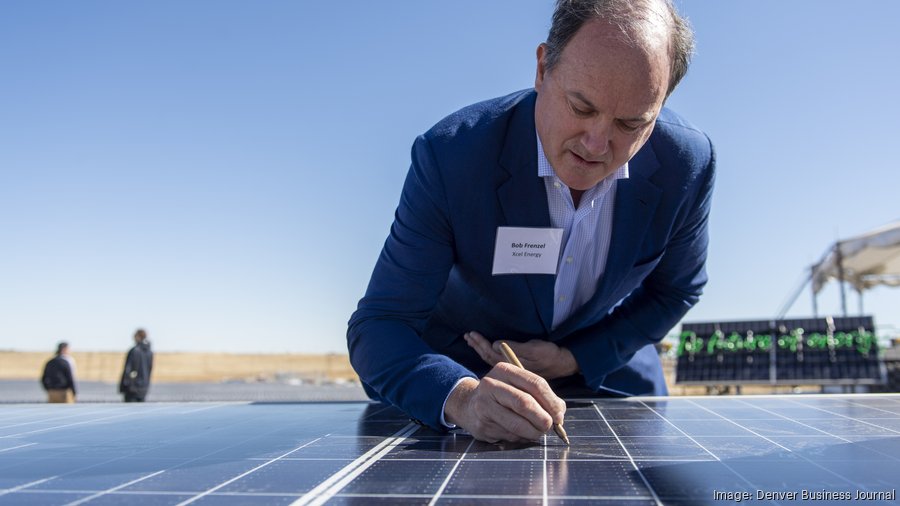A crowd of executives and politicians came together to celebrate Wednesday the largest solar power plant built for a single customer, the EVRAZ North America steel company, whose mill in Pueblo becomes the first in the world that can claim to be powered by the sun.
The project's energy will avoid 433,000 metric tons of carbon dioxide emissions had the power been generated from fossil fuel, a greenhouse gas reduction equal to taking 92,000 cars off the road, the companies say.
Sunny, intense blue skies fittingly greeted the dozens of people flocking to a southern Colorado field stretched between a power plant and a steel mill.
The Bighorn solar plant’s panels stretching between the power plant smokestacks and the steel mill were heralded as the past and future of energy in one place.
“There’s nothing else like it,” said Kevin Smith, CEO of Lightsource BP, which developed the $285 million solar farm. “This is the lead project in all our presentations.”
It’s a project that EVRAZ and Xcel Energy, Colorado’s largest power company, planned together. The 300-megawatt Bighorn solar farm is on steel mill property. Xcel Energy's largest coal-fired power complex, the Comanche plant, sits next door.
Two of Comanche’s three coal-burning units are being shut down by 2025 as Xcel shifts to renewable energy. The plant’s infrastructure for transmitting power to the EVRAZ mill helped make Bighorn possible.
San Francisco-based Lightsource BP, a solar joint venture with energy giant BP (NYSE: BP), financed, designed and operates the Bighorn solar farm which covers nearly 1,800 acres.
The project has been supplying some power to the grid for weeks. The last of the 750,000 solar panels coming online will be generating power next month.
Xcel Energy-Colorado, the utility company of Minneapolis-based Xcel Energy (Nasdaq: XEL), agreed to buy the electricity from Bighorn and locked in a 20-year rate for power it sells EVRAZ, giving the steel mill price a certain power supply through 2041. That certainty was what EVRAZ needed to justify expanding its 150-year-old mill in Pueblo instead of closing it.
“We came together to solve a pretty complex problem,” said Bob Frenzel, president and CEO of Xcel Energy, the parent company of Colorado’s largest power utility.
Xcel Energy has powered the steel mill for 50 years and looks forward to doing that for another 50, he said.
BP America organized Wednesday’s gathering atop a hill in the middle of the Bighorn solar farm, the tilted black, sliver-framed panels lining the gravel road up to a tent. From there, the rest of the 1,800-acre plant spreads out as a shimmering sea of gray below.
“I see a lot of projects, and this is pretty astonishing,” said Mike Kruger, head of the Colorado Solar and Storage Association, adding it’s the largest solar installation he has ever seen.
The Bighorn project grew out of the steel company trying to clinch a reliable, affordable power supply for the mill’s expansion, said Skip Herald, president and CEO of EVRAZ North America.
“My first reaction was to laugh,” when the idea of solar power for the mill was raised, he said.
When it became clear the project was not only feasible but could lock in the affordable electricity the plant needed to stay, he came to view it as a smart collaboration.
“We’re already the cleanest source of steel — at least in the U.S., possibly anywhere — and now you put all this solar on the back side of the mill?” he said overlooking the sea of panels below. “It’s a pretty good story.”

EVRAZ North America, part of a Russian steel conglomerate, is the biggest U.S. recycler of steel, turning 1 million tons of scrap into new products annually. That process was already 75% cleaner, in terms of greenhouse gas emissions, than making steel from ore, Herald said.
The Bighorn solar plant is expected to make nearly enough electricity to cover the plant’s entire power need, officials say.
EVRAZ can sell its steel, claiming it to be the most environmentally friendly steel available, Herald said.
Meanwhile, 1,000 mill jobs will remain in Pueblo. The mill expansion will be complete in 2024.
BP America, the U.S. business of London-based BP plc, wanted Bighorn to attract attention Wednesday to show how the company is evolving.

BP’s U.S. business is run by David Lawler, who’s based in Denver. BP America is most associated in Colorado with its Denver-based BPX Energy onshore oil and gas production, but BP America's low-carbon electricity business owns half of Lightsource BP and the gigawatts of solar energy it’s building across the U.S.
BP tells its investors that its crude oil output worldwide will shrink 40% over the next couple decades. By 2030, BP will be investing $5 billion annually in renewable energy worldwide, and a major portion of that will be in the U.S., Lawler said.
BP America is developing a green energy park in Louisiana and getting into urban electricity grid management, among many other projects.
“All of our businesses are headed in this direction,” Lawler said.
Nick Gradisar, Pueblo’s mayor, worked summers in the steel mill while he was in law school. His grandfather emigrated from Europe to Pueblo and worked at the steel mill for 50 years. Gradisar’s father had a 30-year career there, too.
EVRAZ's commitment to opening its long-rail mill in Pueblo is a big deal for the city, supporting its evolution into a clean energy industrial center, he said. It’s also remarkable that the companies in Bighorn were able to make a solar project capable of generating the power a steel mill needs.
“If you’ve even been in the mill and seen that arc furnace light up, you know what an accomplishment this is,” Gradisar said.
U.S. Sen. Michael Bennet, a Democrat from Denver, toured Bighorn on Thursday. The project and steel mill may be the best example of how renewable energy can help "re-industrialize" the U.S. economy and build domestic manufacturing back up in a way that reduces greenhouse gas emissions.
“What we’re seeing here is that transition and discovering that we can walk with confidence into a future where we address climate change,” Bennet said.

That future isn’t entirely cloudless.
The Bighorn project is being followed by another solar power farm nearby, which Lightsource BP will start building later this year east of the Xcel power plants. That project, called Sun Mountain Solar, is located near another of Xcel’s solar farms, which was among the largest in the U.S. when it was built.
The spreading expanse of solar panels across thousands of acres southeast of Pueblo, which some consider unsightly, has generated resident opposition to more solar in the area.
Pueblo County is considering changing land use rules to limit the concentration of future solar development, said Mike Kruger, head of the COSSA solar trade group.
He’s spending time this fall at public meetings in Pueblo trying to talk the county out of it.
The Pueblo area has a nearly ideal combination of open land, sunlight and electrical power transmission infrastructure to cement it as one of the nation’s leading solar power hubs.
“They could have gigawatts of solar here, if they want it,” he said.
The Bighorn solar plant’s scale may not remain unusual for long as more is invested in renewable energy projects around the U.S.
Soon Bighorn may not even be the largest solar project on Xcel Energy’s systems. The utility company is pursuing a solar project that could be as big as 600 megawatts next to one of its power plants in Minnesota, Frenzel said.

Total # of kilowatts installed
| Rank | Prior Rank | Business name |
|---|---|---|
1 | 1 | Namasté Solar |
2 | 2 | SunShare |
3 | 3 | Pivot Energy |





